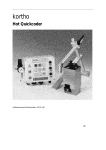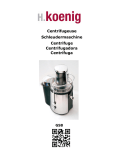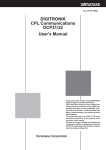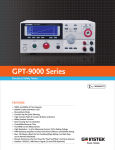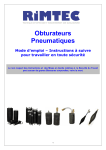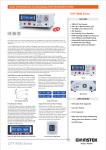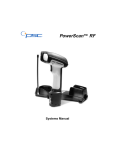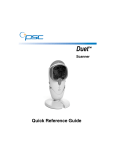Download PSC DUET User`s guide
Transcript
User's Guide PSC Inc 959 Terry Street Eugene, Oregon 97402 Telephone: (541) 683-5700 Fax: (541) 345-7140 An Unpublished Work - All rights reserved. No part of the contents of this documentation or the procedures described therein may be reproduced or transmitted in any form or by any means without prior written permission of PSC Inc. or its wholly owned subsidiaries (“PSC”). Owners of PSC products are hereby granted a nonexclusive, revocable license to reproduce and transmit this documentation for the purchaser’s own internal business pur-poses. Purchaser shall not remove or alter any proprietary notices, including copyright notices, contained in this documentation and shall ensure that all notices appear on any reproductions of the documentation. Should future revisions of this manual be published, you can acquire printed versions by contacting PSC Customer Administration. Electronic versions may either be downloadable from the PSC web site (www.pscnet.com) or pro-vided on appropriate media. If you visit our web site and would like to make comments or suggestions about this or other PSC publications, please let us know via the “Contact PSC” page. Disclaimer Reasonable measures have been taken to ensure that the information included in this manual is complete and accurate. However, PSC reserves the right to change any specification at any time without prior notice. PSC is a registered trademark of PSC Inc. The PSC logo is a trademark of PSC. All other trademarks and trade names referred to herein are property of their respective owners. Table of Contents Introduction ....................................................................................................... 3 Product Overview ............................................................................................. 4 Manual Overview .............................................................................................. 5 Operational Overview ....................................................................................... 6 Fixed/Portable Mode ................................................................................ 6 Targeted Handheld Mode ......................................................................... 7 Duet Scanner Controls ..................................................................................... 9 Connectors ..................................................................................................... 10 Sleep Mode .................................................................................................... 11 Unpacking ...................................................................................................... 12 Verifying Scanner Operation ........................................................................... 13 Countertop Installation .................................................................................... 15 Scanner Stand Installation ...................................................................... 15 Connecting the Scanner ................................................................................. 20 Power-Up Procedure .............................................................................. 20 Troubleshooting .............................................................................................. 23 Problem Isolation .................................................................................... 23 Isolated Scanner Test ............................................................................. 24 How To Scan .................................................................................................. 25 Fixed Mode Scanning ............................................................................. 25 Portable scanning ................................................................................... 29 Targeted Handheld Scanning ................................................................. 30 Customizing Your Scanner's Operation .......................................................... 33 Changing The Volume ............................................................................ 33 Other Programmable Features ............................................................... 34 Routine Maintenance ...................................................................................... 36 Appendix A - Specifications ............................................................................ 37 Appendix B - Regulatory Agency Information ................................................. 41 User's Guide 1 Blank Page 2 Duet ™ Scanner Introduction The Duet™ scanner from PSC®, shown in Figure 1, delivers high performance in a small, fixed scanner which can also be used as a targeted handheld scanner. Its innovative design maximizes productivity, and minimizes operator stress, strain and fatigue. The Duet scanner's compact size uses very little counter space. The product is designed for durability, prolonged life, and low maintenance costs. With three scanning options: fixed, portable, and targeted handheld, the Duet scanner is versatile and flexible. You can bring small items to the scanner, or take the scanner to large bulky items. Figure 1. Duet™ Scanner User's Guide 3 Product Overview The Duet scanner is primarily designed for presentation and sweep scanning from a fixed position. The scanner can also be removed from the stand for use as a portable (multi-line) scanner or a single line handheld scanner. Use the Duet scanner's front scan window for presentation and sweep scanning, and the rear scan window for targeted handheld scanning. Figure 2 shows the Duet scanner used as: (1) fixed, (2) portable, and (3) a targeted handheld scanner. Figure 2. Duet scanner used as: (1) Fixed, (2) Portable Scanner, or (3) Targeted Handheld Scanner a. Front Scan Window b. Bar code c. Stand 4 d. Trigger Switch e. Rear Scan line f. Rear Scan Window Duet ™ Scanner Duet Scanner Features The Duet scanner features include: • A rugged industrialized enclosure which encompasses the entire scanning mechanism. • An adjustable stand that tilts to hold the scanner at the best reading angle. • An LED lamp and speaker provide both visual and audible feedback to the user ( i.e. "good read" of scan, or end of Selftest). • Balanced weight and a shape designed to fit the hand comfortably and reduce fatigue. • An Anti-Skid Dot and durable rubber moulding around the front scan window, keep the scanner in place when resting face down on the counter. • The rear scan line can be programmed to be always on or on only when the trigger is pulled. Manual Overview This manual provides an overview of the Duet scanner, describes the scanner features, and provides instructions to unpack, install and operate the Duet scanner. The Routine Maintenance section describes procedures to clean and maintain the scanner. Appendix A, Specifications, provides physical, environmental, and electrical specifications. Appendix B, Regulatory Agency Information, provides information on Agency and Regulatory compliance. User's Guide 5 Operational Overview The scanner has three operational modes: • Fixed/Portable Mode • Targeted Handheld Mode • Sleep Mode This section describes the three operational modes while the section How to Scan, describes how to use the scanner in the Fixed/Portable and Targeted operational modes. Fixed/Portable Mode In the Fixed Mode, the scanner remains fixed in the stand and reads while a bar code is swept past or presented to the front scan window. You can also remove the scanner from the stand and present or sweep the scanner over the bar code using the front scan window (Portable Mode). Figure 3 shows the scanner in the Fixed Mode with (1), the item presented to the scanner, and (2), the Portable Mode where the scanner is presented to the item. Figure 3. Scanning in (1) Fixed and (2) Portable Mode 6 Duet ™ Scanner Targeted Handheld Mode Remove the scanner from the stand to use it in the Targeted Handheld Mode. Pressing the trigger switch enables targeted scanning. (See Figure 4). The Targeted Handheld Mode allows the scanner to read bar codes selectively. A Pointer Line provides a visual aid for aiming the single scan line at the bar code. Press the switch once for each bar code scanned. This mode is particularly useful for reading a single bar code where multiple bar codes exist in the same area. The Fixed/Portable Mode is disabled while the trigger switch is pressed. Figure 4. Targeted Handheld Mode a. Trigger Button b. Rear Scan Window c. Pointer Line User's Guide d. Scan Depth e. Scan Line 7 Controls & Indicators The controls, indicators and connectors for the Duet scanner are described in this section. They include: • Trigger switch • Visual Indicator (LED) • Speaker • Interface cable connector Figure 5, below, shows the features, controls, indicators and connectors of the Duet scanner. Figure 5. Features, Controls and Indicators a. b. c. d. e. 8 Visual Indicator (LED) Trigger Switch Front Window Protector Front scan Window Anti Skid Dot f. g. h. i. Stand Speaker Rear Scan Window Interface/ DC Powered Connector Duet ™ Scanner Duet Scanner Controls Trigger Switch Pressing the trigger switch causes the scanner to enter the Targeted Handheld Mode. In this mode, the scanner reads bar codes with a single scan line projected from the rear scan window. Releasing the trigger switch returns the scanner to the Fixed/ Portable Scanning Mode. Pressing and releasing the trigger switch will also wake up the scanner, if it has entered Sleep Mode, and return it to normal operation. This feature is a backup to the motion sensor’s automatic wakeup function. Indicator Lamp The Light Emitting Diode (LED) indicates various system operations and provides visual error indicators. The indicator lamp has four active modes: • On dim – Indicates that the scanner is operational and ready to scan. This is the normal operating condition. • Flashes once brightly when the scanner has read a bar code to indicate a good read. This is usually accompanied by a good read tone from the speaker. • Flashing from dim to bright once per second indicates the scanner is in the Sleep Mode due to an extended time of inactivity. • Flashing repeatedly accompanied by a series of tones indicates a failure has occurred. If your scanner exhibits this behavior or behaves erratically, contact your service personnel. User's Guide 9 Speaker The speaker produces an audible indication of scanner operation. The tones are: • Normal Tone – A single tone when the scanner reads a bar code indicates a good read. • Passed Selftest – A series of four tones are emitted when power is first applied to the scanner. This indicates the scanner passed the Selftest and is operating properly. • Error Tone – The speaker sounds a series of tones alerting the operator of a possible system or component failure. If your scanner exhibits this behavior or behaves erratically, contact your service personnel. Connectors Interface Connector This connector provides the link between the scanner and the host terminal. It transmits bar code data and, depending on your system configuration, can also, supply power to the scanner from the host terminal. D.C. Power Connector The DC power connector is for connecting the optional AC/DC power supply to the scanner. This power supply is not required if the scanner uses the Power-Off Terminal (P.O.T.) feature. WARNING Use only AC/DC Power Supplies approved for the Duet scanner and ordered from PSC. Use of other power supplies may cause damage to the product which is not covered by the factory warranty. 10 Duet ™ Scanner Sleep Mode Sleep Mode is the term used to describe the scanner’s condition after the motor and/or laser have automatically switched off due to a prolonged period of inactivity. Motion Sensor The scanner includes a motion sensor that detects activity in front of the scan window. Waving your hand or merchandise in front of the window wakes the scanner up when it is in Sleep Mode. In certain low-level lighting conditions, it may be necessary to press the trigger button to wake up the scanner. User's Guide 11 Unpacking Before you open the Duet scanner shipping carton, inspect the exterior of the carton for damage. If the carton is torn or crushed, carefully open and inspect the contents to ensure that no damage has occurred to contents. Notify your carrier immediately if you think that there has been any damage to the contents. When you open the shipping carton, you should find: • User's Guide (This Manual) • Duet scanner • Stand • Standard mounting hardware • Interface cable (Optional) • AC/DC power supply (if required) If anything is missing or the wrong interface cable has been included with your scanner, contact your dealer/distributor or call your local PSC office. In the U.S. and Canada, call PSC Customer Support Services at (800) 547-2507. Otherwise, refer to the list on the back cover for the PSC office closest to you. Figure 6. Package Contents a. b. c. d. Duet Scanner Stand Interface Cable* (Optional) User's Guide e. f. g. h. AC/DC Power Supply, if required Standard Mounting Hardware Two Sided Tape (2 Strips) Mounting Screws (2) * Your Interface Cable may vary from the illustration. 12 Duet ™ Scanner Verifying Scanner Operation External Power Supply – If you have a Duet scanner with the optional external power supply, you can verify scanner operation prior to installation to ensure the scanner is fully functional. Follow these procedures to verify scanner operation if you have the optional external power supply. (Reference Figure 7): 1. Plug the scanner end of the interface cable into the rear of the scanner until it clicks into place. 2. Plug the DC plug (of the AC/DC power supply) into the DC receptacle on the interface cable. 3. Plug the AC/DC power supply into a functional AC power outlet. 4. The scanner will run a Power-Up Selftest. Passes Selftest – The scanner should emit four successive tones indicating that it has passed the Power-Up Selftest routine. The LED indicator lamp flashes brightly once. The LED then transitions to a dim condition, indicating the scanner is ready for operation. Verify operation by scanning a few bar codes. NOTE Since the scanner is not connected to a host terminal, it may read only one or two bar codes before it must be reset. This is normal because some terminal interfaces require the scanner to store bar code data until the POS terminal signals that it is ready to receive the data. Fails Selftest – If the scanner powers-up, but the LED lamp begins flashing and the speaker repeats a series of tones, go to the section titled, Problem Isolation. User's Guide 13 Power-Off-Terminal (P.O.T. Option) – If your scanner uses Power-OffTerminal (P.O.T.), the scanner must be connected to the host terminal to verify the scanner operation. The P.O.T. option requires an interface cable designed to supply power as well as transmit bar code data. To verify the scanner operation with the P.O.T. option follow the steps in the section Power-Up Procedures. Then refer to the previous paragraphs, Passes Selftest or, Fails Selftest, depending on the scanner’s behavior. Figure 7. Verifying Scanner Operation a. Interface Connector b. Interface Cable c. Host Terminal Connector* d. DC Power Supply Connector e. AC/DC Power Supply * Actual Host Terminal connector may vary from illustration. 14 Duet ™ Scanner Countertop Installation The scanner stand has non-skid rubber feet on the bottom, and is weighted to keep the stand stable. It may be placed on the countertop with no additional installation. The stand may also be permanently mounted to the countertop. Scanner Stand Installation Free Standing – NO additional installation is required when the scanner stand is not attached to the countertop. Fixed Installation – The Duet scanner may be secured to the countertop in two ways: • Install the scanner using double sided tape affixed to the baseplate. • Mount the stand to the countertop using the screw slots in the baseplate. Tape Installation To install the scanner using the two sided tape: 1. Remove the four rubber feet from the bottom of the stand. 2. Remove the backing from the one side of the tape and attach the tape to the baseplate on the bottom of the stand as shown in Figure 8. 3. Remove the backing for the outer side of the tape. User's Guide 15 Figure 8. Installing Tape onto Stand a d b c b c a. Remove feet (4) b. Two sided Tape 4. 16 c. Backing, Peel off d. Baseplate Position the scanner stand in the desired location and press the stand firmly to countertop for a few seconds. Duet ™ Scanner Figure 9. Installing Stand to Countertop a b a. Stand b . Countertop Mounting the Stand using Screws The scanner base may be attached to the countertop using the mounting screws provided. Use the template at the back of this manual to help locate the mounting holes. The following procedures refer to Figure 10 on the next page. 1. Position the template where you want to install the scanner. Use the template at the back of this manual to locate the holes for the two mounting screws. User's Guide 17 2. Mark the hole position and drill two pilot holes, approximately 1/8 inches (.3 cm) diameter and 3/4 inches (2.0 cm) deep, into the countertop. 3. Install the two mounting screws, but do not tighten. Leave the heads of the screws approximately 5/16 inches (1 cm) above the countertop as shown in panel 3 on the opposite page. 4. Place the scanner stand over the two mounting screws, aligning the large openings with the screw heads. 5. Twist the stand firmly, but gently, in a clockwise direction to engage the screws in the baseplate slot. NOTE It may be necessary to readjust the height of the mounting screws to obtain a good fit. The mounting screws should be adjusted until no up and down movement of the base is detected, but not so tight as to prevent the base from being removed from the mounting screws. 6. This completes the stand installation. You may wish to drill an additional 3/4 inch (2.0 cm) hole near the scanner for routing the interface cable to the host terminal. 18 Duet ™ Scanner Figure 10. Installing the Scanner Stand 1 2 a d hes ) inc 2.5 5 cm (6.3 c Front C PS et Du ide Gu er's Us b 3 b 4 f e 6 5 g a. b. c. d. Template Countertop Drill two pilot holes Drill User's Guide e. Approximately 5/16 inches f. Mounting Screws g. Stand Installation Complete 19 Connecting the Scanner The Duet scanner connects to the store host terminal via an interface cable. The cable connects to the scanner with a modular connector and to the host terminal with the connector required by the host (RS-232, OCIA, Keyboard Wedge, Wand or IBM POS). DC power to the scanner is supplied by one of two methods: 1. From the host terminal (Power-Off-Terminal) through a special cable that carries both data and DC power. 2. From an optional AC/DC power supply that provides DC power, either through the side of a connector, or connected to a special connector attached to the interface cable. Figure 11 shows how to connect the scanner to the store host terminal. The type of DC power connector depends on your existing store host terminal. Power-Up Procedure The system power-up procedure may vary depending on the requirements of your Point-of-Sale (POS) system. Always power-down (switch off) all equipment prior to connecting cables. Check with your system supervisor and/or refer to the terminal operator's manual for proper power-down and power-up procedures for your system. To connect the scanner: Power-Off-Terminal (P.O.T.) 1. Connect the interface cable to the scanner. 2. Connect the interface cable to the host terminal. Power-up the system and scan a few items to verify that data is properly communicated between the scanner and your POS terminal. 20 Duet ™ Scanner AC/DC power supply (if required) 1. 2. Connect the interface cable to the scanner. Connect the DC barrel plug into the side of the connector, or into the DC power connector. 3. Connect the interface cable to the host terminal. 4. Plug the AC/DC power supply into a functional AC outlet. Power up the system and scan a few items to verify that data is properly communicated between the scanner and your POS terminal. Figure 11. Connecting the Scanner to the Host Terminal a. Interface Connector b. DC Power Connector c. Host Terminal Connector* d. To Host Terminal e. Interface Cable f. AC/DC Power Supply *Your Host Terminal Connector may vary from illustration User's Guide 21 You have completed the scanner installation and power-up procedures. If problems occur, follow the procedures titled Problem Isolation on the next page. If you want to modify the scanner's interface parameters or change the user interface (e.g. speaker tone length), order the Duet scanner Programming Guide (PSC Part Number R44-1740). 22 Duet ™ Scanner Troubleshooting Problem Isolation START Is the LED flashing brightly? Are multiple tones emitted ? NO Go to the Isolated** Scanner Test flowchart on the next page. YES NO Does the scanner read bar codes ? Is the YES Green lamp lit (dim)* ? *If the green lamp is flashing NO **You will need an AC/DC power supply and an interface cable that accepts external power in order to isolate and verify the scanner's operation. YES slowly, the scanner is in the Sleep Mode. Wave your hand near the Front Scan Window to "wake it up," or press the trigger switch. Does NO your scanner use AC/DC power supply ? Move the scanner to a known good terminal,or replace the interface cable. YES YES Is the data displayed on the terminal ? NO Verify that the 1. Interface cable is plugged into the scanner. 2. DC power plug is connected to the barrel-type plug on the interface cable. 3. AC/DC power supply is connected to a functional AC outlet. (Reference Figure 10). Problem is: • terminal • interface hardware or • interface software Call your system support personnel No Problem Found User's Guide 23 Isolated Scanner Test NOTE If you have a scanner that uses Power-Off theTerminal (P.O.T.), you cannot perform this test unless you are able to substitute a cable that uses an AC/DC power supply connected as shown in Figure 10. 1. Disconnect Power Disconnect the AC/DC power supply from the AC power outlet. 2. Disconnect Interface Disconnect the scanner's interface cable connector from the host terminal. Did the scanner pass Selftest ? YES Is the green LED lit dimly ? YES 3. Reconnect Power After you have disconnected the interface cable connector, reconnect the AC/DC power supply. Will the scanner read bar codes* ? YES 4. Selftest Routine The scanner performs a complex Power-Up Selftest that checks operation of the scanner hardware and software. If successful, the beeper sounds four tones and the green lamp lights, indicating the scanner passed the Selftest. NO Potential problems: • Record the number of tones emitted by the scanner. Call your system support personnel. NO Potential problems: • Lamp failed • Scanner failure Call your system support personnel. NO Potential problems: • Poor bar code quality • Bar code symbology is not enabled • Scanner failure Call your system support personnel. Scanner O.K. Problem is either interface cable, or terminal. * With the interface cable disconnected from the host terminal, the scanner may only read one or two bar codes before it must be reset. Unplug and reconnect the AC/DC power supply to reset the scanner. 24 Duet ™ Scanner How To Scan With two scan windows, the Duet scanner can easily adapt to either fixed/portable or targeted handheld scanning applications. The front scan window, with its multiple scan pattern, is used for most retail items. The rear scan window emits a single targeted scan pattern for handheld scanning of hard to read or bulky items, or to read an individual bar code among many bar codes. Fixed Mode Scanning Fixed Mode scanning provides ease of use by reducing the need to pick up the scanner to read a bar code. Its specially designed scan pattern minimizes the need for the operator to adjust the item for scanning. The scanner stand adjusts forward and backwards to an optimal and comfortable position for increased efficiency. For most applications, the best scanning position is straight up and down. Figure 12 shows the range of movement available. Figure 12. Scanner Position Adjustment a. Optimal position for most applications User's Guide 25 To use the scanner in Fixed Mode, place the scanner into the stand. Make sure it is seated securely. In the Fixed Mode, the scanner can read bar codes either in the sweep or presentation mode to accommodate different user styles. Sweep Scanning To perform a sweep scan, move (sweep) the product, with the bar code facing the front window, laterally through the scan volume. As shown in Figure 13, the scan volume for fixed scanning extends approximately 9 inches (23 cm) in front of the scan window. Figure 13. Scan Volume and Scan Depth a. Rear Scan Window b. Front Scan Window c. Scan Volume d. Scan Depth The optimal scanning distance is at the center of the scan volume, or approximately 4.5 inches (11 cm) from the window. 26 Duet ™ Scanner Figure 14 shows the motion of the item swept past the front scan window. Figure 14. Sweep Scanning a b maxwe ll a. Front Scan Window b. Bar code faces the Scan Window User's Guide 27 Presentation Scanning To obtain optimum scanning performance, face the bar code towards the center of the front scanner window. Move the product with the bar code towards the scanner, as shown in Figure 15. Figure 15. Presentation Scanning 2HD 28 Duet ™ Scanner Portable scanning The Duet scanner is also portable. To use as a portable scanner, remove the scanner from the stand but do not press the trigger switch. Present (or sweep) the scanner to the bar code using the front scan window as shown in Figure 16. Figure 16. Portable Scanning a b c a. Front Scan Window b. Bar code c. Stand User's Guide 29 Targeted Handheld Scanning Targeted handheld scanning allows the operator to point the scanner instead of lifting heavy or bulky items that are in the customer's hands or shopping cart. A specially designed Pointer Line helps the operator visually aim at the desired bar code. The scanner's shape cradles comfortably in the operator's hand. Its weight is distributed evenly to maximize balance and minimize fatigue. To use the Duet scanner as a targeted handheld scanner: 1. Grasp the scanner in the palm of the hand with the thumb positioned on or near the trigger switch. 2. Lift the scanner from the stand and position the scanner over the product to be scanned. (See Figure 17). Figure 17. Using Duet Scanner as a Targeted Handheld Scanner a. Thumb on Trigger Switch 30 b. Rear Scan Window Duet ™ Scanner 3. Use the Pointer Line to help locate the center of the bar code before pressing the trigger switch (Figure 18). Small bar code labels need to be close to the scan window, while larger bar code labels should be farther away. Figure 18. Locating the pointer a. Trigger Switch b. Rear Scan Window c. Scan Line User's Guide d. Scan Depth e. Pointer Line 31 4. Use your thumb to press the trigger switch to scan the bar code as shown in Figure 19. Release the trigger switch when you hear the "good read" tone. Figure 19. Press Trigger switch to Line Scan a b a. Rear Scan Window b. Trigger Switch To continue scanning in the Targeted Handheld Mode, repeat the process above: (3), placing the Pointer Line on the next item’s bar code, and (4), pressing the trigger switch. 32 Duet ™ Scanner Customizing Your Scanner's Operation Customizing or programming a scanner provides maximum flexibility and allows a single scanner to serve many installation environments. Since the Duet scanner supports a variety of interfaces, configurations and bar code symbologies, it may be necessary to customize your scanner to meet the specific requirements of your retail environment. Customizing the scanner is done by scanning special bar codes which change the way the scanner operates. The Duet scanner is extremely flexible. If the scanner does not read bar codes and transmit data the way you need it to, contact your dealer or distributor for more programming options. Changing The Volume There are three possible volume settings. Each time you scan this bar code, the scanner’s volume changes to the next higher level. If the current volume is the highest selection, the volume changes to the lowest setting. If the scanner is powered off or reset, this setting returns to the factory default and will need to be set again to your desired setting. For permanent volume change, see the Duet scanner Programming Guide. Increment Volume User's Guide 33 Other Programmable Features The table below shows some of the major features that may be changed using the Programming Guide (PSC Part Number R44-1740). Programmable Features Symbology Activation/Deactivation – Code 39 – Code 128 – Interleaved 2 of 5 – Codabar – MSI/Plessey Symbology Data Customization – Convert UPC/EAN to another UPC/EAN format – Check Digit Calculation – Check Digit Transmission – Minimum Number of Reads before Transmission – Code 39 Stitching – Code 39 Full ASCII – Fixed Label Lengths Host Communications Parameters – RS-232 – Keyboard Wedge – IBM 46XX – OCIA – Wand Emulation Sleep Mode – Motor Time-out – Laser Time-out User Indicators Parameters – Speaker Volume Selection – Speaker Tone Pitch – Speaker Tone Length Double Read Time-out 34 Duet ™ Scanner Other programmable features available include: • Supplemental labels • Coupon Processing • Two label configuration • Data Editing • Label ID prefixes Contact PSC for more information on these programmable features. User's Guide 35 Routine Maintenance The Duet scanner is designed to be rugged and requires little maintenance. Routine maintenance consists of cleaning the scanner windows periodically. Cleaning the Front and Rear Scan Windows Regular cleaning of the window surfaces of the scanner reduces residue buildup and helps ensure the system’s highest performance. WARNING DO NOT USE ALCOHOL, PETROLEUM, ACETONE, ABRASIVE CLEANING OR ABRASIVE PADS. THEY WILL HARM OR SCRATCH THE SURFACE. Use these procedures for cleaning the scanner's front and rear scan windows. NOTE The scanner windows are high quality, optical grade plastic. Use a soft lens cloth and non-abrasive cleaner to avoid scratching. 1. Spray the cleaner on a soft, lint-free cloth and gently clean the window surfaces. s as Gl aner Cle 2. 36 Completely wipe window surfaces dry with a soft, lint-free cloth. Duet ™ Scanner Appendix A - Specifications Physical Specifications Scanner Height = 7.00" (17.8 cm) Width = 3.25" (8.3 cm) Depth = 2.60" (6.6 cm) Weight = 9.0 oz (0.26 kg) Stand Diameter = 4.70" (12.0 cm) Height = 2.56" (6.5 cm) Weight = 10.5 oz (0.30 kg) AC/DC Power Supply Length = 2.75" (6.7 cm) Width = 2.10" (5.2 cm) Height = 2.80" (7.3 cm) Weight = 10.0 oz (.29 kg) User's Guide 37 Environmental Specifications Operation Temperature 0°C (32°F) +40°C (+104°F) Humidity 5 - 95 % (non-condensing) Ambient Light 200 footcandles (2150 Lux) maximum Storage Temperature -40°C (-40°F) +70°C (+158°F) Humidity 5 - 95 % (non-condensing) 38 Duet ™ Scanner Electrical Specifications The Duet scanner can draw power from an approved external AC/DC power supply, or can receive power from the host terminal. WARNING Use only AC/DC Power Supplies approved for the Duet scanner and ordered from PSC. Use of other power supplies may cause damage to the product which is not covered by the factory warranty. Scanner Input Power Specifications Input voltage Power Consumption Input Voltage Ripple 4.7 to 14 volts DC 3.0 Watts maximum 500 mV DC maximum External AC to DC power Supply Output: 12 VDC @ 600 mA User's Guide 39 AC to DC power Supplies The AC to DC power supplies available for the scanner are listed in the table below. Power Supplies for other countries are available. Country Australia Canada France Germany Italy United States Japan Mexico Scandinavia Spain United Kingdom Voltage Frequency 240 120 220 220 220 120 100 120 220 220 240 50 HZ 60 HZ 50 HZ 50 HZ 50 HZ 60 HZ 50 HZ 60 HZ 50 HZ 50 HZ 50 HZ Power-Off-Terminal (P.O.T.) If power is supplied by the host terminal, the host must provide power compatible with the Input Power Specifications. For example, a 12V system must provide at least 250mA (3 Watts). 40 Duet ™ Scanner Appendix B Regulatory Agency Information FCC Statements This device complies with Part 15 of the FCC rules and the Radio Interference Regulation of the Canadian Department of Communications for a Class A computing device. Operation is subject to the following two conditions: 1. This device may not cause harmful interference. 2. This device must accept any interference received including interference that may cause undesired operation. This equipment has been tested and found compliant with the limits for a Class A digital device, pursuant to Part 15 of the FCC rules. These limits are designed to provide reasonable protection against harmful interference when the equipment is operated in a commercial environment. This equipment generates, uses and can radiate radio frequency energy and, if not installed and used in accordance with the instruction manual, may cause harmful interference to radio communications. Operation of this equipment in a residential area is likely to cause harmful interference, in which case the user will be required to correct the interference at his or her own expense. The electrical socket for this product must be located near the scanner and be readily accessible to the operator. • This Class A digital apparatus meets all requirements of the Canadian Interference-Causing Equipment Regulations. • Cet appareil numerique de la classe A respecte toutes les exigences du Reglement sur le material broilleur du Canada. User's Guide 41 Agency Compliance The Duet scanner meets or exceeds the requirements for its device type as set forth by the following agencies and regulations: Electrical • Underwriter’s Laboratories, UL Standard 1950, for Electrical Safety • Canadian Standards Association, Standard for Electrical Safety, C22.2 No. 950-M89 • TÜV Electrical Safety, according to EN60 950A3:1995/ EN60825-1: 1994 + A11:1996. Emissions • United States Federal Communications Commission, Class A Emission Limits defined by Part 15, Subpart J, 47CFR • Canadian Federal Communications Commission, Class A Emission Limits • Class B, EN55022 (Europe) • AS/NZ 4251, per C-Tick Mark (EN55022-B) (Australia/ N. Zealand) • Korean Bureau of Standards (S. Korea) • VCCI Class 2 or better (Japan) Laser Safety • United States Laser Safety, CDRH Class IIa (Reference 21 CFR part 1040) • Canadian Laser Safety, Class IIa • Laser Safety, Class I, according to IEC 825-1:1993 • Standards Association of Australia, Laser Safety Standard AS 2211-1995 Approvals in other countries pending. Contact PSC Marketing at (541) 683-5700 for a complete listing. 42 Duet ™ Scanner Scanner Labeling This artwork shows label placement ONLY. For actual regulatory, patent and other applicable information, view the labels on the product itself, or call your nearest sales or service office. Product Identification 2 A Laser Caution Labels 1 Caution- Laser Radiation when open. Do not stare into Beam B PSC S c a n n i n g , I n c . Eugene, OR. 97402 USA Model: xxxxx S/N: xxxxxxxxx Mfg: XXXXXXXX XXX Regulatory Labels 2 UL ® Listed NWGQ C 2Z78 U A ACN Class IIa Laser Product - Avoid long term viewing of direct laser light. Apparell a laser de classe IIa Eviter toute exposition prolongee de la vue a lumier laser directe. C Laser Caution Labels 1 3 Patent Label Inside Enclosure D Interface Label (Visible through interface connector opening). This device is covered by patents. Complies with 21 CFR 1040 and part 15 of FCC Rules. Class 1 laser product, IEC 825-1:1993 C Regulatory Labels 2 a. Laser Caution Labels b. Product Identification c. Regulatory Labels d. Interface Label 1. These labels are etched into the exterior of the scanner enclosure. These labels are affixed to the exterior of the scanner enclosure. 3. Other Patents are pending. 2. User's Guide 43 Laser Safety Information The Duet scanner requirements for laser safety are based on IEC Standard Publication 825-1:1993 and EN60825:1994 (Europe), CDRH 21CFR, Part 1040 (United States and Canada), and AS 2211:1995 (Australia). Class I and Class IIa products are not considered to be hazardous. The Duet scanner contains internally a Visible Laser Diode (VLD) that emits a maximum of 455µW at a wavelength of 650 to 670 nanometers. The scanner is designed so that there is no human access to harmful laser light during normal operation, user maintenance or during prescribed service operations. WARNING • Use of controls or adjustments or performance of procedures other than those specified herein may result in hazardous laser light. • Do not attempt to open or otherwise service any component in the optics cavity. Opening or servicing any part of the optics cavity by unauthorized personnel may violate safety regulations. The optics system is a factory repair item. • Use of optical instruments with the scanner will increase eye hazard. Optical instruments include binoculars, microscopes and magnifying glasses. This does not include eye glasses worn by the user. 44 Duet ™ Scanner Standard Warranty PSC warrants to Customer that PSC's products will be free from defects in materials and workmanship for a period of one year from product shipment. In order to obtain service under this Warranty, Customer must notify PSC of the claimed defect before the expiration of the Warranty period and obtain from PSC a return authorization number for return of the product to designated PSC service center. If PSC determines Customer’s claim is valid, PSC will repair or replace product without additional charge for parts and labor. Customer shall be responsible for packaging and shipping the product to the designated PSC service center, with shipping charges prepaid. PSC shall pay for the return of the product to Customer if the shipment is to a location within the country in which the PSC service center is located. Customer shall be responsible for paying all shipping charges, duties, taxes, and any other charges for products returned to any other locations. Warranty is subject to the limitations and exclusions set forth below. Warranty set forth above is in lieu of any other warranties, expressed or implied, including merchantability and fitness. Exclusions Warranty coverage shall not apply to any claimed defect, failure or damage which PSC determines was caused by: improper use of product; failure to provide product maintenance, including but not limited to cleaning of the scan windows in accordance with product manual; installation or service of product by other than PSC representatives; use of product with any other instrument, equipment or apparatus; modification or alteration of product. External cables and replacement of scan windows due to scratching, stains or other degradation will not be covered under the Warranty. Products returned for service must be accompanied by the original external power supplies for performance of service. Limitations of Liability PSC repair or replacement of defective product as set forth above is the customer's sole and exclusive remedy on account of claims of breach of warranty or product defect. Under no circumstances will PSC be liable to customer or any third party for any lost profits, or any incidental, consequential indirect, special or contingent damages regardless of whether PSC had advance notice of the possibility of such damages. Assignment Customer may not assign or otherwise transfer its rights or obligations under Warranty except to a purchaser or transferee of product. No attempted assignment or transfer in violation of this provision shall be valid or binding upon PSC. Risk of Loss Customer shall bear risk of loss or damage for product in transit to PSC. PSC shall assume risk of loss or damage for product in PSC’s possession or product being returned to Customer by PSC, except such loss or damage as may be caused by the negligence of Customer, its agents or employees. In the absence of specific written instructions for the return of product to Customer, PSC will select the carrier, but PSC shall not thereby assume any liability in connection with the return shipment. User's Guide 45 46 Duet ™ Scanner International Caution Statements French Le scanner DUET est certifié conforme aux conditions requises par la norme DHHS/CDRH 21CRF, sous-chapitre J, concernant les appareils à laser de classe IIa aux Etats-Unis. Le scanner DUET est aussi certifié en tant qu'appareil à laser de classe I conforme aux conditions requises par la norme IEC 825-1:1993. Les produits de classe I et classe II ne sont pas considérés comme dangereux. Le scanner DUET contient une diode laser visible (VLD) qui émet une puissance maximum de 455µW pour une longueur d'onde de 650 to 670 nanomètres. Le scanner est conçu pour que l'accès à des niveaux dangereux de luminière laser ne soit pas possible pendant l'utillisation normale, l'entretien par l'utilisateur ou les fonctions de dépannage recommandées. ATTENTION • L'utilisation de procédures de contrôle, régage ou utilsation autres que celles spécifidées dans ce document peut entraîner une exposition dangereuse à la lumière du laser. • Ne pas essayer d'ouvrir ni de réparer les composants de la cavité optique. L'ouverture ou la réparation d'une partie de la cavité optique par une personne non qualifée peut entraîner la violation des regeles de sécurité relatives au laser. Le système optique peut être réparé qu'en usine. • L'utilsation d'instruments optiques avec le scanner augmentera le danger pour les yeux. Les instruments optiques comprennent les jumelles, les microscopes et les loupes. Ils ne comprennent pas les lunettes portées par l'utilsateur. User's Guide 47 Blank Page DECLARATION OF CONFORMITY PSC hereby declares that the Equipment specified below has been tested and found compliant to the following Directives and Standards: Directives: Low Voltage EMC 89/336/EEC 73/23/EEC Standards: EN 55022-B EN 60825-1 EN 50082-1 EN 60950 Equipment Type: Bar Code Scanning Equipment Product: Duet™ Scanner, Model 43 Series Brad West Vice President Quality and Process Management PSC, Inc. 959 Terry Street Eugene, OR 97402 U.S.A. Peter Lomax Vice President Europe, Middle East & Africa PSC Bar Code Ltd. Axis 3, Rhodes Way Watford Hertfordshire WD24 4TR UK Asia Pacific PSC Hong Kong Hong Kong Telephone: [852]-2-584-6210 Fax: [852]-2-521-0291 Italy PSC S.p.A. Vimercate (MI), Italy Telephone: [39] (0) 39/62903.1 Fax: [39] (0) 39/6859496 Australia PSC Asia Pacific Pty Ltd. North Ryde, Australia Telephone: [61] 0 (2) 9878 8999 Fax: [61] 0 (2) 9878 8688 Japan PSC Japan K.K. Shinagawa-ku, Tokyo, Japan Telephone: 81 (0)3 3491 6761 Fax: 81 (0)3 3491 6656 France PSC S.A.R.L. LES ULIS Cedex, France Telephone: [33].01.64.86.71.00 Fax: [33].01.64 46.72.44 Latin America PSC S.A., INC. Miami, Florida, USA Telephone: (305) 539-0111 Fax: (305) 539-0206 Germany PSC GmbH Darmstadt, Germany Telephone: 49 (0) 61 51/93 58-0 Fax: 49 (0) 61 51/93 58 58 United Kingdom PSC Bar Code Ltd. Watford, England Telephone: 44 (0) 1923 809500 Fax: 44 (0) 1923 809 505 www.pscnet.com PSC Inc. 959 Terry Street Eugene, OR Telephone: (541) 683-5700 Fax: (541) 345-7140 ©2004 PSC INC. R44-1730 (Rev.D) 03/04




















































